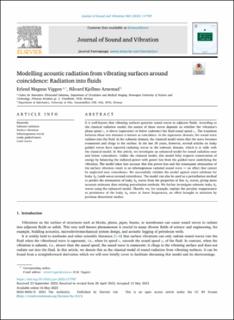| dc.contributor.author | Viggen, Erlend Magnus | |
| dc.contributor.author | Arnestad, Håvard | |
| dc.date.accessioned | 2023-05-26T06:23:54Z | |
| dc.date.available | 2023-05-26T06:23:54Z | |
| dc.date.created | 2023-05-25T17:00:30Z | |
| dc.date.issued | 2023 | |
| dc.identifier.citation | Journal of Sound and Vibration. 2023, 560 . | en_US |
| dc.identifier.issn | 0022-460X | |
| dc.identifier.uri | https://hdl.handle.net/11250/3069077 | |
| dc.description.abstract | It is well-known that vibrating surfaces generate sound waves in adjacent fluids. According to the classical radiation model, the nature of these waves depends on whether the vibration’s phase speed cv is above (supersonic) or below (subsonic) the fluid sound speed cf. The transition between these two domains is known as coincidence. In the supersonic domain, the sound wave radiates into the fluid. In the subsonic domain, the classical model states that the wave becomes evanescent and clings to the surface. In the last 30 years, however, several articles on leaky guided waves have reported radiating waves in the subsonic domain, which is at odds with the classical model. In this article, we investigate an enhanced model for sound radiation near and below coincidence. Unlike the classical model, this model fully respects conservation of energy by balancing the radiated power with power lost from the guided wave underlying the vibration. The model takes into account that this power loss and the consequent attenuation of the surface vibration result in an inhomogeneous radiated sound wave — an effect that cannot be neglected near coincidence. We successfully validate the model against exact solutions for leaky A0 Lamb waves around coincidence. The model can also be used as a perturbation method to predict the attenuation of leaky A0 waves from the properties of free A0 waves, giving more accurate estimates than existing perturbation methods. We further investigate subsonic leaky A0 waves using the enhanced model. Thereby we, for example, explain the peculiar reappearance or persistence of the leaky A0 wave at lower frequencies, an effect brought to attention by previous theoretical studies. | en_US |
| dc.description.abstract | Modelling acoustic radiation from vibrating surfaces around coincidence: Radiation into fluids | en_US |
| dc.language.iso | eng | en_US |
| dc.publisher | Elsevier | en_US |
| dc.rights | Navngivelse 4.0 Internasjonal | * |
| dc.rights.uri | http://creativecommons.org/licenses/by/4.0/deed.no | * |
| dc.subject | Overflatebølger | en_US |
| dc.subject | Surface waves | en_US |
| dc.subject | Akustisk emisjon | en_US |
| dc.subject | Acoustic emission | en_US |
| dc.subject | Akustikk | en_US |
| dc.subject | Acoustics | en_US |
| dc.subject | Vibrasjoner | en_US |
| dc.subject | Vibration | en_US |
| dc.title | Modelling acoustic radiation from vibrating surfaces around coincidence: Radiation into fluids | en_US |
| dc.title.alternative | Modelling acoustic radiation from vibrating surfaces around coincidence: Radiation into fluids | en_US |
| dc.type | Peer reviewed | en_US |
| dc.type | Journal article | en_US |
| dc.description.version | publishedVersion | en_US |
| dc.subject.nsi | VDP::Elektromagnetisme, akustikk, optikk: 434 | en_US |
| dc.subject.nsi | VDP::Electromagnetism, acoustics, optics: 434 | en_US |
| dc.source.pagenumber | 20 | en_US |
| dc.source.volume | 560 | en_US |
| dc.source.journal | Journal of Sound and Vibration | en_US |
| dc.identifier.doi | 10.1016/j.jsv.2023.117787 | |
| dc.identifier.cristin | 2149378 | |
| dc.relation.project | Norges forskningsråd: 237887 | en_US |
| cristin.ispublished | true | |
| cristin.fulltext | original | |
| cristin.qualitycode | 2 | |

